Abstract
Toxic shock syndrome (TSS) is a recently recognized acute multisystem illness that may recur. Epidemiologic links with menstruation and use of tampons have been identified. We report the cases of seven patients (six women and one man), 12 to 31 years old, seen over nine months, who met the criteria for TSS. Four were menstruating at onset. All had hypotension, fever, erythematous rash and distal desquamation. A prodrome of myalgias and diarrhea occurred in all patients. Clinical features of the acute illness included pharyngitis, conjunctivitis, leukocytosis and renal dysfunction (7), hepatobiliary abnormalities (6), mental confusion (6) and coagulopathy (4). In three patients, examination of cerebrospinal fluid showed abnormalities. The illness progressed in three patients to adult respiratory distress syndrome and significant cardiac dysfunction. Staphylococcus aureus was isolated from mucosal sites in six. The disease recurred in two. There were no deaths. Possible transmissibility was illustrated by two patients, a married couple, with simultaneous illnesses. Pathophysiologic features of TSS suggest a toxicogenic cause. Management consists of early recognition, vigorous fluid resuscitation, inotropic support as needed, discontinuation of tampon use and treatment with antistaphylococcal antimicrobic drugs.
Full text
PDF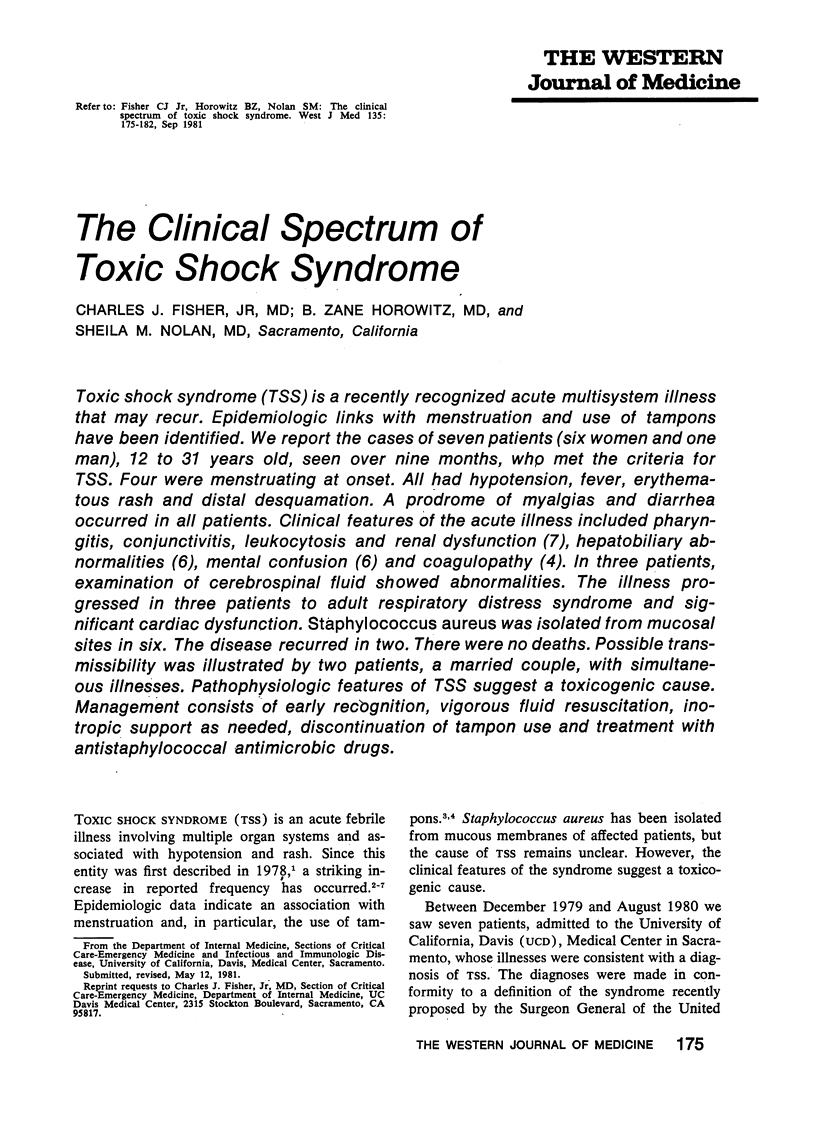
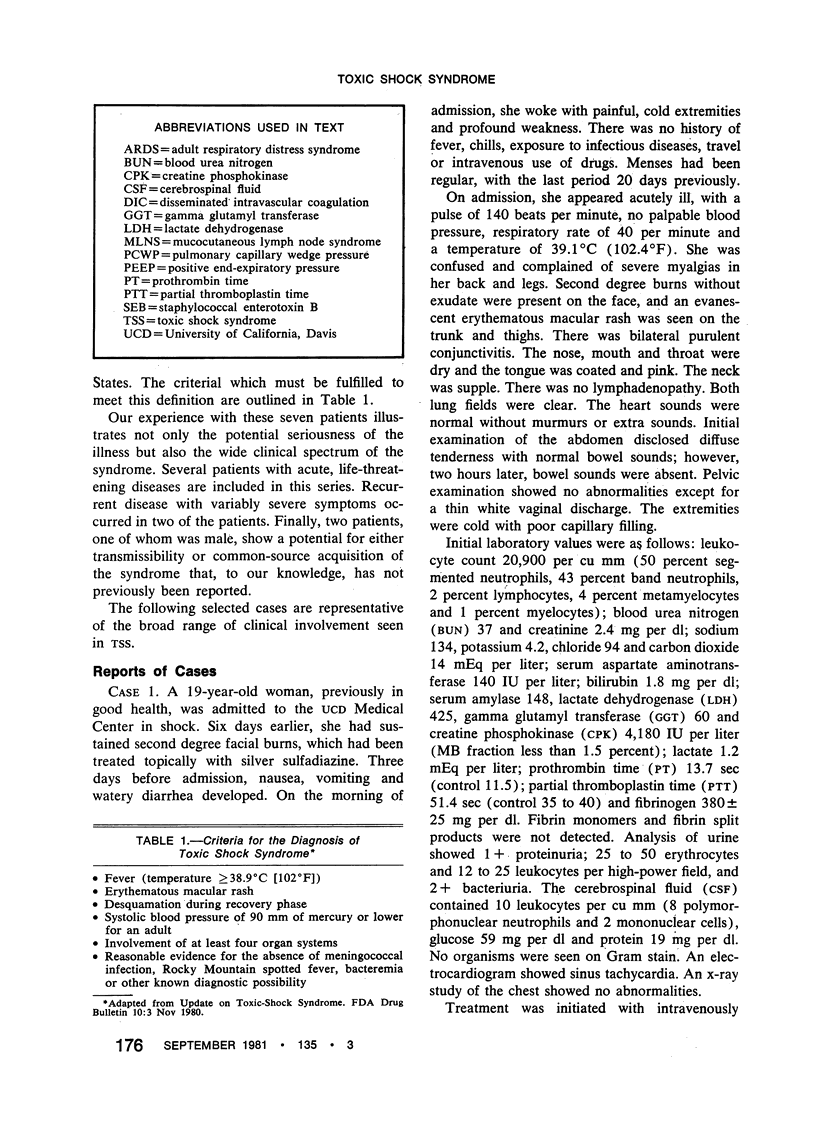
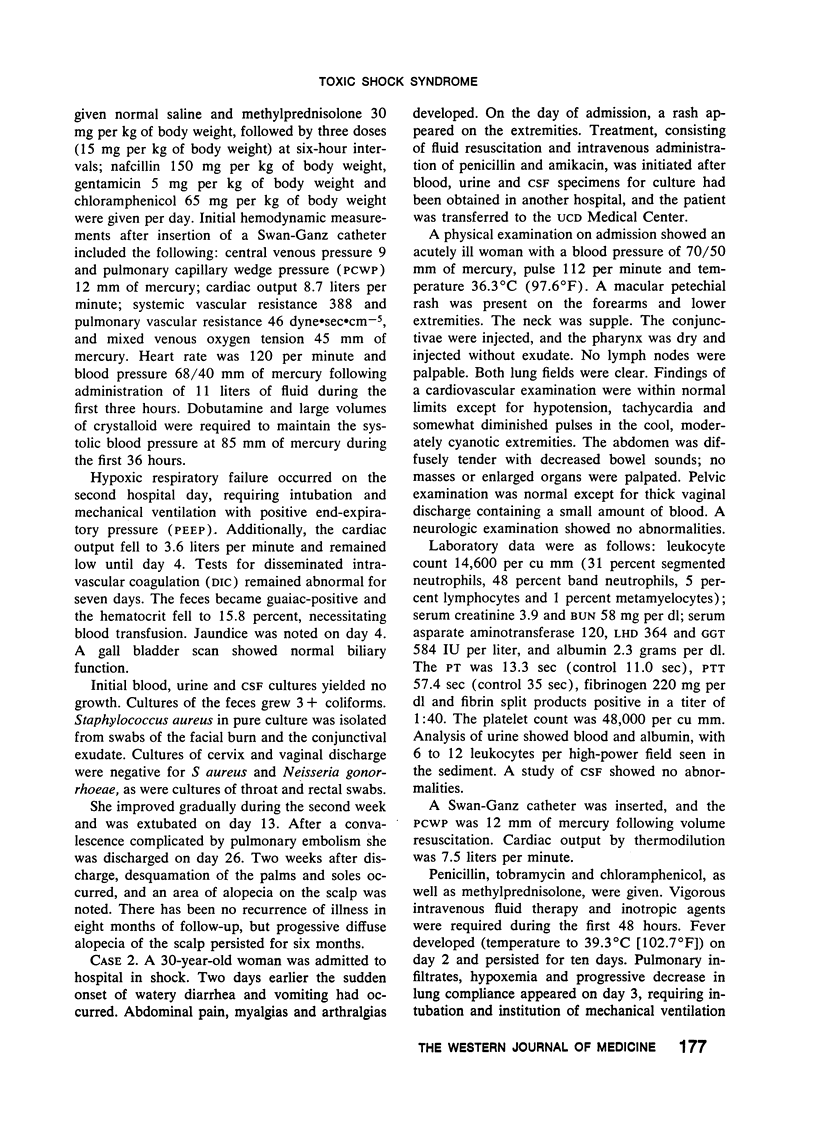
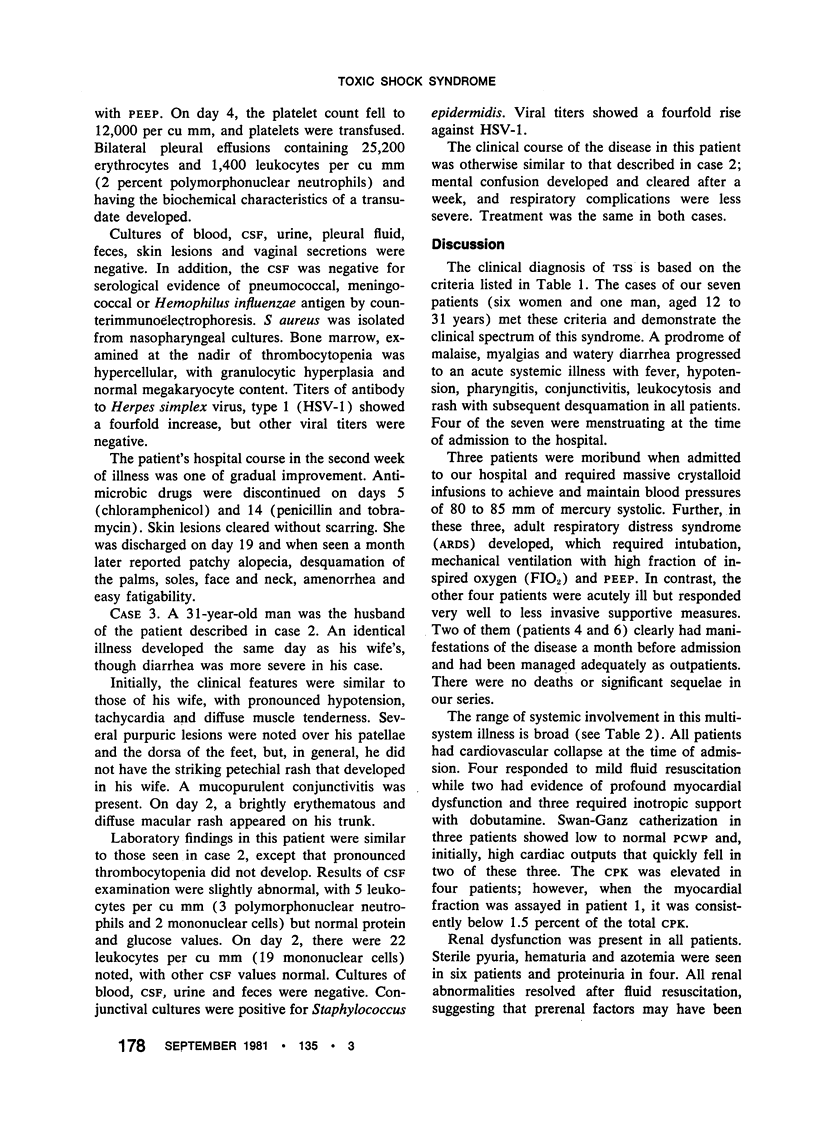
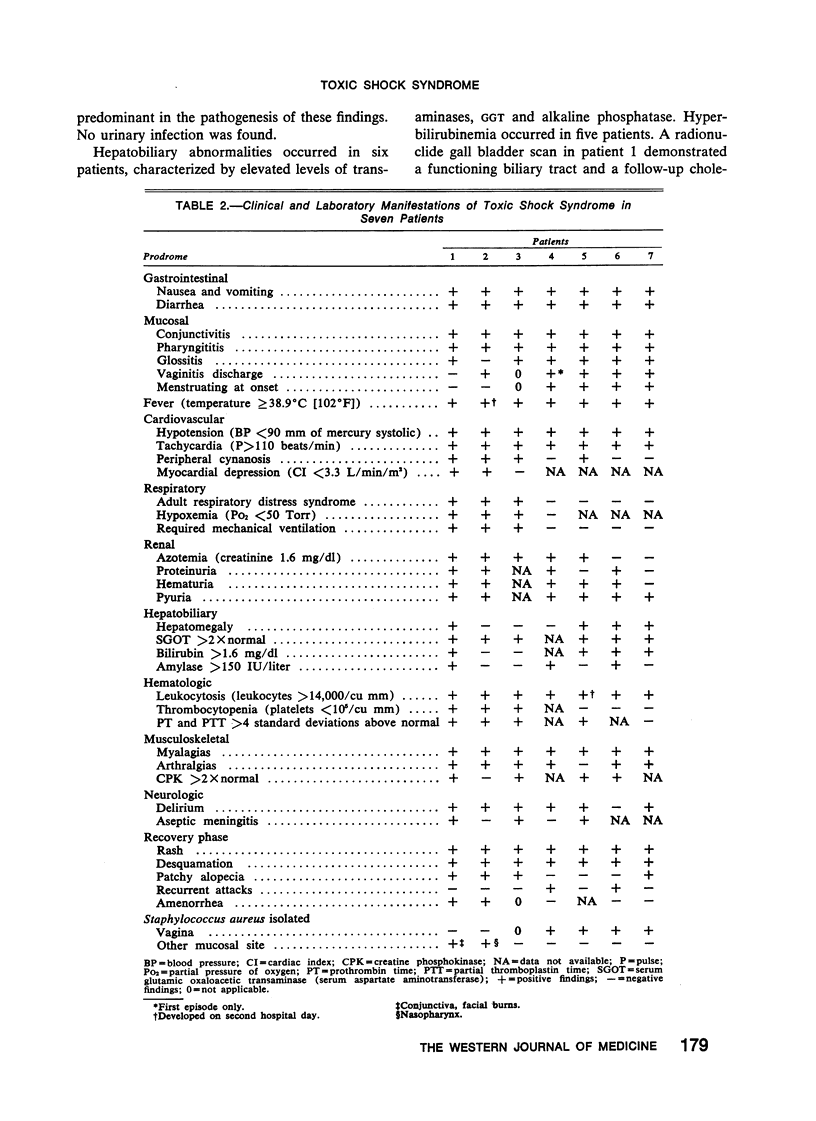
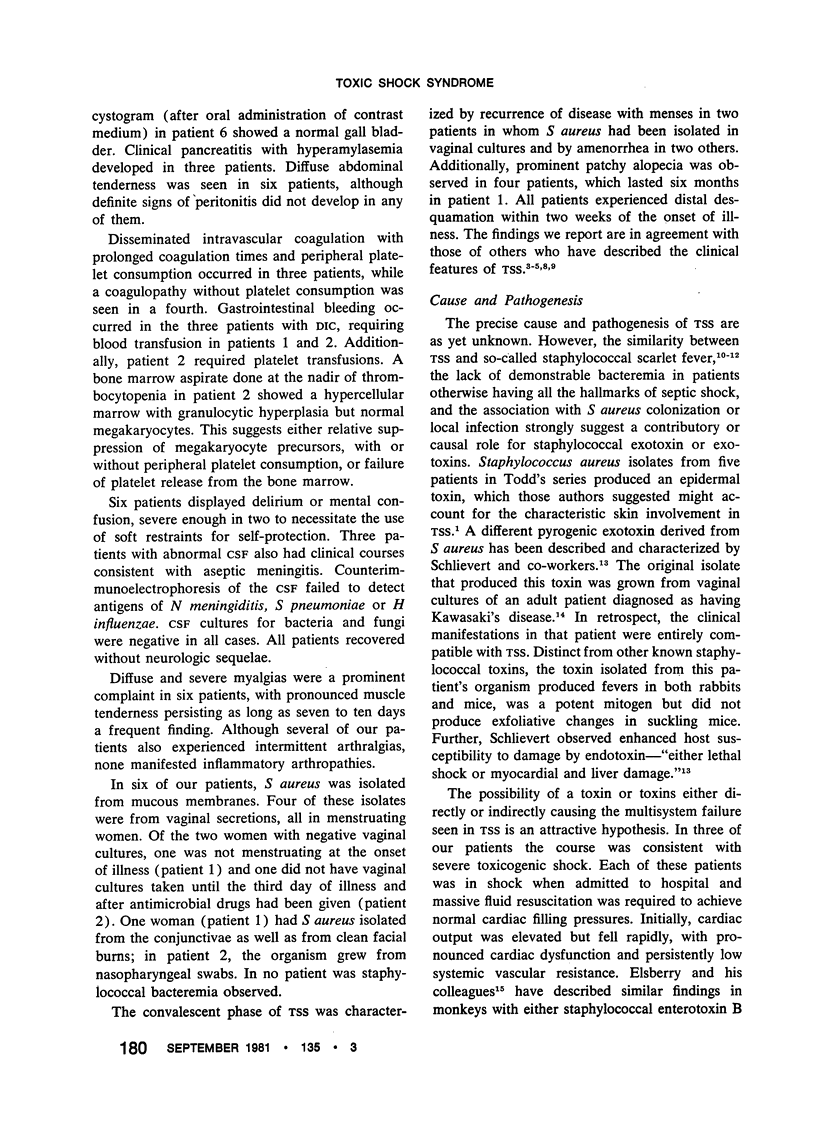
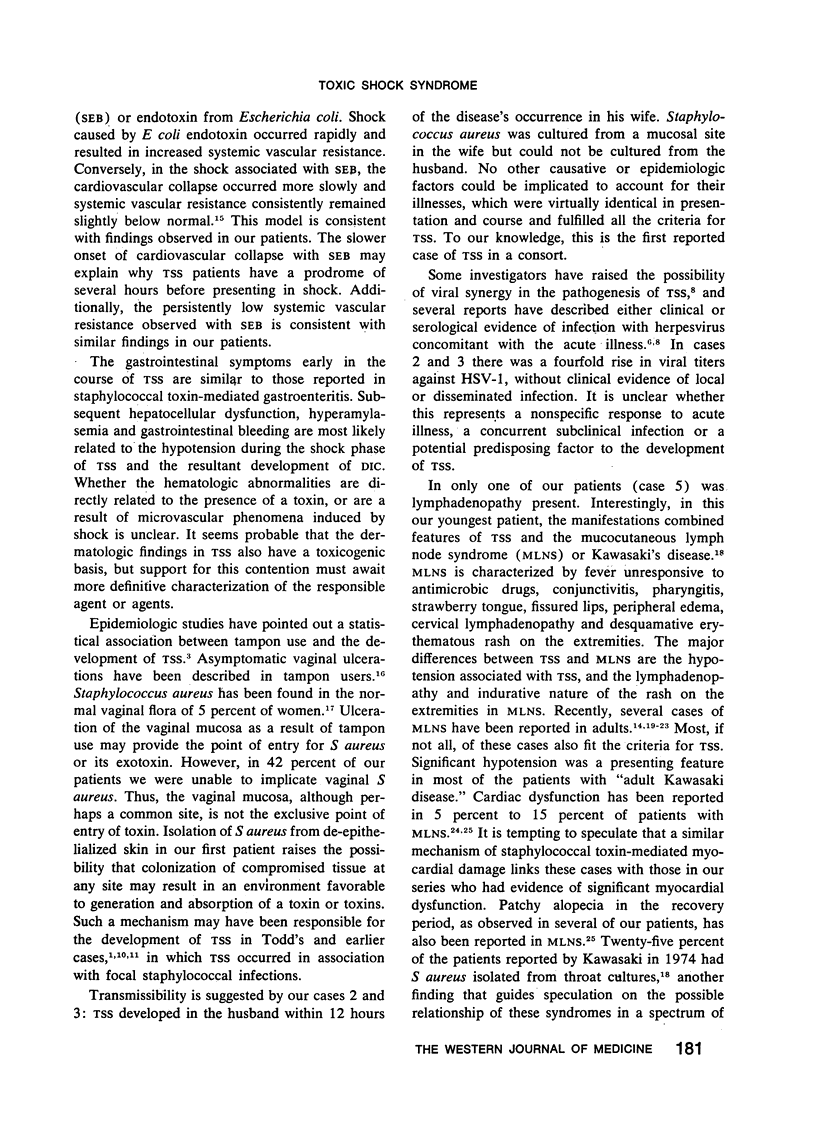
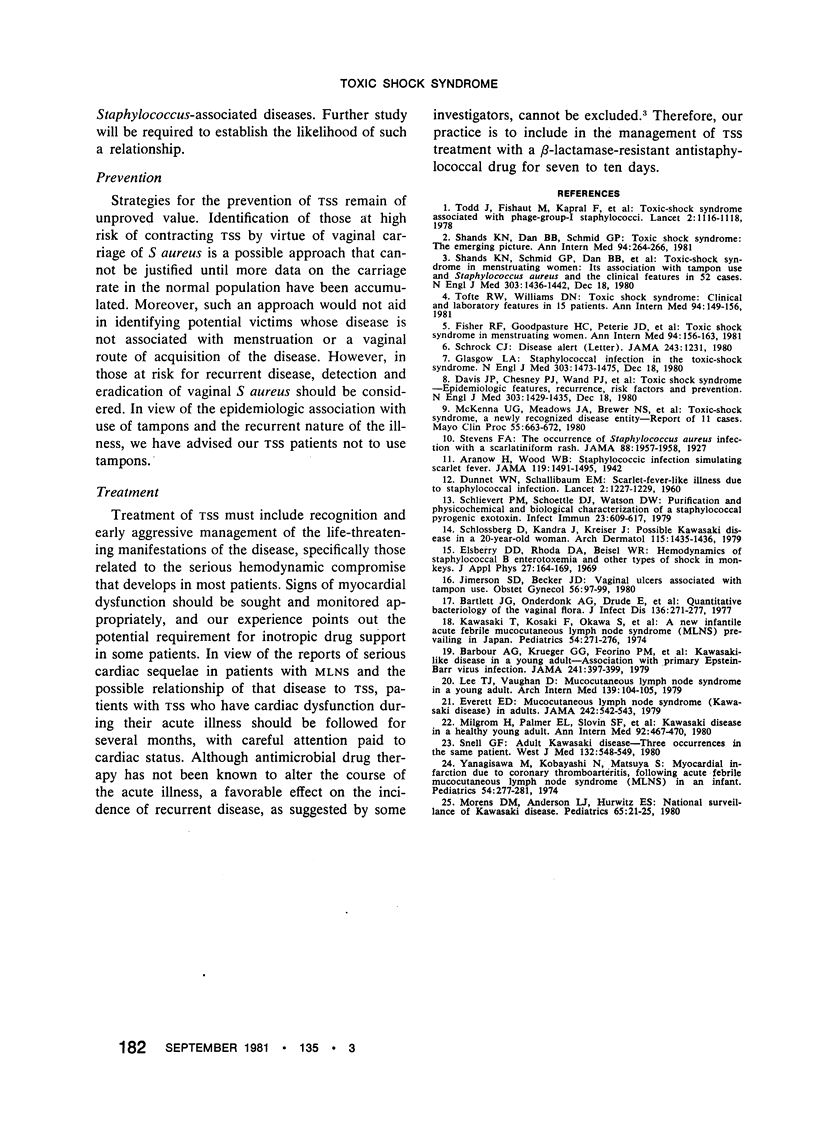
Selected References
These references are in PubMed. This may not be the complete list of references from this article.
- Barbour A. G., Krueger G. G., Feorino P. M., Smith C. B. Kawasaki-like disease in a young adult. Association with primary Epstein-Barr virus infection. JAMA. 1979 Jan 26;241(4):397–398. [PubMed] [Google Scholar]
- Bartlett J. G., Onderdonk A. B., Drude E., Goldstein C., Anderka M., Alpert S., McCormack W. M. Quantitative bacteriology of the vaginal flora. J Infect Dis. 1977 Aug;136(2):271–277. doi: 10.1093/infdis/136.2.271. [DOI] [PubMed] [Google Scholar]
- DUNNET W. N., SCHALLIBAUM E. M. Scarlet-fever-like illness due to staphylococcal infection. Lancet. 1960 Dec 3;2(7162):1227–1229. doi: 10.1016/s0140-6736(60)92418-1. [DOI] [PubMed] [Google Scholar]
- Davis J. P., Chesney P. J., Wand P. J., LaVenture M. Toxic-shock syndrome: epidemiologic features, recurrence, risk factors, and prevention. N Engl J Med. 1980 Dec 18;303(25):1429–1435. doi: 10.1056/NEJM198012183032501. [DOI] [PubMed] [Google Scholar]
- Elsberry D. D., Rhoda D. A., Beisel W. R. Hemodynamics of staphylococcal B enterotoxemia and other types of shock in monkeys. J Appl Physiol. 1969 Aug;27(2):164–169. doi: 10.1152/jappl.1969.27.2.164. [DOI] [PubMed] [Google Scholar]
- Everett E. D. Mucocutaneous lymph node syndrome (Kawasaki disease) in adults. JAMA. 1979 Aug 10;242(6):542–543. [PubMed] [Google Scholar]
- Fisher R. F., Goodpasture H. C., Peterie J. D., Voth D. W. Toxic shock syndrome in menstruating women. Ann Intern Med. 1981 Feb;94(2):156–163. doi: 10.7326/0003-4819-94-2-156. [DOI] [PubMed] [Google Scholar]
- Glasgow L. A. Staphylococcal infection in the toxic-shock syndrome. N Engl J Med. 1980 Dec 18;303(25):1473–1475. doi: 10.1056/NEJM198012183032508. [DOI] [PubMed] [Google Scholar]
- Jimerson S. D., Becker J. D. Vaginal ulcers associated with tampon usage. Obstet Gynecol. 1980 Jul;56(1):97–99. [PubMed] [Google Scholar]
- Kawasaki T., Kosaki F., Okawa S., Shigematsu I., Yanagawa H. A new infantile acute febrile mucocutaneous lymph node syndrome (MLNS) prevailing in Japan. Pediatrics. 1974 Sep;54(3):271–276. [PubMed] [Google Scholar]
- Lee T. J., Vaughan D. Mucocutaneous lymph node syndrome in a young adult. Arch Intern Med. 1979 Jan;139(1):104–105. [PubMed] [Google Scholar]
- McKenna U. G., Meadows J. A., 3rd, Brewer N. S., Wilson W. R., Perrault J. Toxic shock syndrome, a newly recognized disease entity. Report of 11 cases. Mayo Clin Proc. 1980 Nov;55(11):663–672. [PubMed] [Google Scholar]
- Milgrom H., Palmer E. L., Slovin S. F., Morens D. M., Freedman S. D., Vaughan J. H. Kawasaki disease in healthy young adult. Ann Intern Med. 1980 Apr;92(4):467–470. doi: 10.7326/0003-4819-92-4-467. [DOI] [PubMed] [Google Scholar]
- Morens D. M., Anderson L. J., Hurwitz E. S. National surveillance of Kawasaki disease. Pediatrics. 1980 Jan;65(1):21–25. [PubMed] [Google Scholar]
- Schlievert P. M., Schoettle D. J., Watson D. W. Purification and physicochemical and biological characterization of a staphylococcal pyrogenic exotoxin. Infect Immun. 1979 Mar;23(3):609–617. doi: 10.1128/iai.23.3.609-617.1979. [DOI] [PMC free article] [PubMed] [Google Scholar]
- Schlossberg D., Kandra J., Kreiser J. Possible Kawasaki disease in a 20-year-old woman. Arch Dermatol. 1979 Dec;115(12):1435–1436. [PubMed] [Google Scholar]
- Schrock C. G. Disease alert. JAMA. 1980 Mar 28;243(12):1231–1231. [PubMed] [Google Scholar]
- Shands K. N., Dan B. B., Schmid G. P. Toxic shock syndrome: the emerging picture. Ann Intern Med. 1981 Feb;94(2):264–266. doi: 10.7326/0003-4819-94-2-264. [DOI] [PubMed] [Google Scholar]
- Shands K. N., Schmid G. P., Dan B. B., Blum D., Guidotti R. J., Hargrett N. T., Anderson R. L., Hill D. L., Broome C. V., Band J. D. Toxic-shock syndrome in menstruating women: association with tampon use and Staphylococcus aureus and clinical features in 52 cases. N Engl J Med. 1980 Dec 18;303(25):1436–1442. doi: 10.1056/NEJM198012183032502. [DOI] [PubMed] [Google Scholar]
- Snell G. F. Adult kawasaki disease-three occurrences in the same patient. West J Med. 1980 Jun;132(6):548–549. [PMC free article] [PubMed] [Google Scholar]
- Todd J., Fishaut M., Kapral F., Welch T. Toxic-shock syndrome associated with phage-group-I Staphylococci. Lancet. 1978 Nov 25;2(8100):1116–1118. doi: 10.1016/s0140-6736(78)92274-2. [DOI] [PubMed] [Google Scholar]
- Tofte R. W., Williams D. N. Toxic shock syndrome: clinical and laboratory features in 15 patients. Ann Intern Med. 1981 Feb;94(2):149–156. doi: 10.7326/0003-4819-94-2-149. [DOI] [PubMed] [Google Scholar]
- Yanagisawa M., Kobayashi N., Matsuya S. Myocardial infarction due to coronary thromboarteritis, following acute febrile mucocutaneous lymph node syndrome (MLNS) in an infant. Pediatrics. 1974 Sep;54(3):277–280. [PubMed] [Google Scholar]


